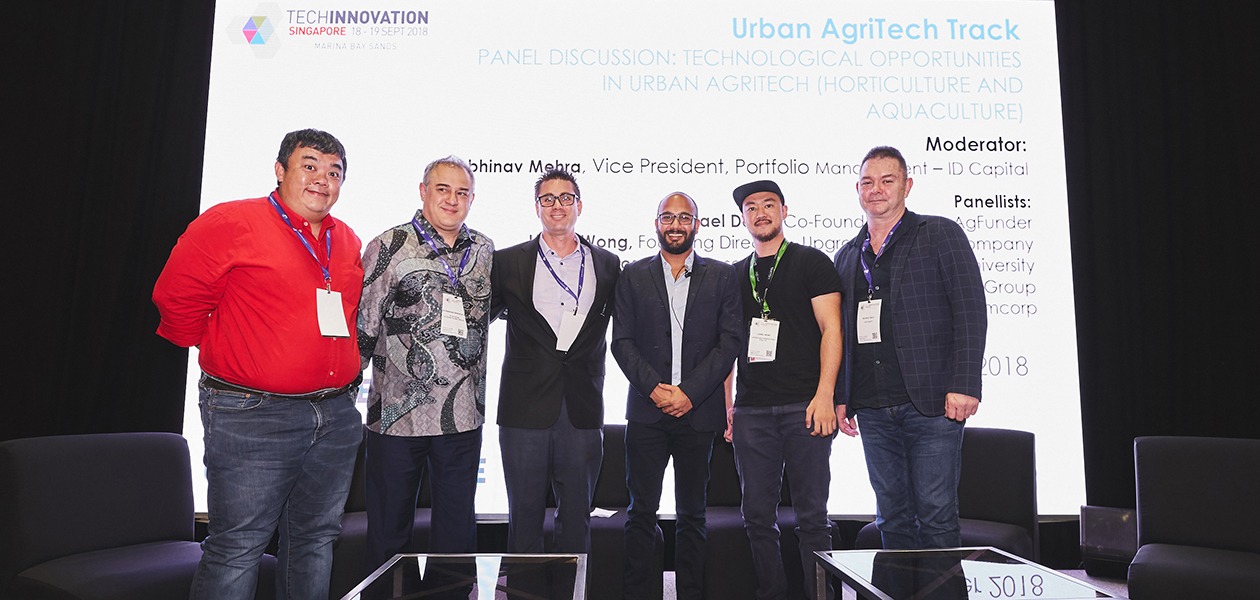Producing food in urban centres
As sensor technology and genetic tools converge, even cities now become hubs of agricultural activity.
With rapid population growth, increasing urbanisation and a shrinking rural labour force, food production methods need to be modernised if society is to feed 9.7 billion mouths by 2050.
Technology is a key enabler of productivity in many industries, and agriculture is no exception. Not only can it improve the yields of conventional farming, it also allows urban spaces to be converted into intensive food factories. Urban agricultural technology—or urban agritech, as the field has come to be known—was a new innovation track at TechInnovation 2018 and featured a host of technologies that make it possible to cultivate anything from vegetables to fish in the heart of cities.
“When I started in the aquaculture business 20 years ago, one of my mentors said, ‘We can farm shrimp or fish on the moon, but how much is it going to cost?’ It’s the same question with farming in the city. However we now have the knowledge and technology to bring farming closer to the consumer market,” said Dr Jose Domingos, Senior Research Fellow at James Cook University, during a panel discussion titled ‘Technological Opportunities in Urban Agritech’.
Joining him on the panel were Michael Dean, Co-founder and CIO of Agfunder; Lionel Wong, Founding Director of Upgrown Farming Company; Dr Farshad Shishehchian, President and CEO of Blue Aqua International Group; and Allan Lim, Founder and Chairman of Comcrop. Abhinav Mehra, Vice President of Portfolio Management at ID Capital, moderated the session.
Producing more with less
Intensifying production was a focal point of discussion among the panellists. Because urban farms typically occupy smaller land areas, the output per square foot has to be increased substantially for the farm to be profitable.
“Profitability is directly tied to technology and knowledge,” said Dr Shishehchian, who highlighted that in aquaculture, it takes a combination of technologies to enable intensification. “[To increase the yield of urban farms] you need to have good water management, nutrition, disease prevention, genetics—there are many factors, like a chain connected to each other.”
Often, the technologies to secure these factors come from other domains and need to be adapted to the agriculture industry. “A lot of the technologies that we are using today come from the precision engineering industry, the information and communications industry and the bioscience industry,” Lim explained. “Innovations such as sensors, automated dosing systems, climate controls reduce the need for intensive labour while enabling a higher-skilled workforce to participate in agriculture.”
Despite the array of technological solutions to choose from, Wong reminded urban farmers that they should prioritise the type of innovations to invest in according to their needs. “Resist the urge to just jump on the bandwagon. Using artificial intelligence (AI) or automation for a farm that’s 100 square feet—it makes no sense. Choose the right combination of technologies to suit the objective of the farm… whether you’re serving the mass market or generating a niche product,” he said.
Innovation embedded in DNA
Among the many technological solutions raised at the discussion, the panellists agreed that genetic tools are a critical driver of the urban agritech revolution. For example, genetics is being used to identify fish species as well as track their source.
“We’re exploring various aspects of DNA barcoding technology to enable rapid screening of fish, which would provide assurance to customers of what they’re eating,” said Dr Magnus Bergkvist, Head of Science and Research, Global Innovation, at Thai Union Group during a keynote address. In terms of traceability, Dr Bergkvist added that the genetic methods used in Europe to track origin beef stocks could be applied to fish, although the technology still requires further development and validation.
Beyond screening and tracking, genomic selection techniques are now used to improve fish stocks. Dr Domingos highlighted that in the aquaculture sector, only 10 percent of all farmed species involves genetically-improved stocks; the remaining 90 percent is still in its wild state.
Given the relatively low cost of gene sequencing technology, he believes that modern fish farmers will be able to screen the genomes of fish species and “use AI to predict the genetic merit of an animal”, be it for disease resistance or growth. Tweaking the genomes of farmed fish species to potentially produce ‘superfish’ is also now possible with a gene editing tool called CRISPR. “It is important to stress that these are not transgenic or GMO technologies,” he said.
However, Dean noted how the European Union (EU) now considers CRISPR to be a technology to produce genetically-modified organisms (GMOs). This means that farmers in the EU are banned from using CRISPR-improved breeding stocks, be it for horticulture or aquaculture. Therefore, while technological fixes may be readily available, regulation may prove to be a stumbling block for urban agritech in certain geographies.
Export technology, not food
All the speakers agreed, however, that open innovation was the way to go for urban agritech to flourish. Dr Bergkvist described how approximately 80 percent of early research activities at Thai Union group involve some form of interaction with academia. “We also engage in collaboration with companies throughout the supply chain management, as well as small companies developing technological solutions.”
In Singapore, Dr Domingos thinks that there is “the perfect storm of start-ups, universities, polytechnics, investors and government agencies working together to encourage innovation [in urban agritech]”.
Rather than aim to become a leading food producer for the region, the speakers believed that Singapore should export its urban agritech innovations to the rest of the region, which will allow it to eventually reap benefits from increased food production in neighbouring countries.
“The way to move forward is to grow a value chain that supports agriculture in the city so that every [agritech innovation] is already fit-for-use and farmers can simply plug and play,” concluded Lim.

